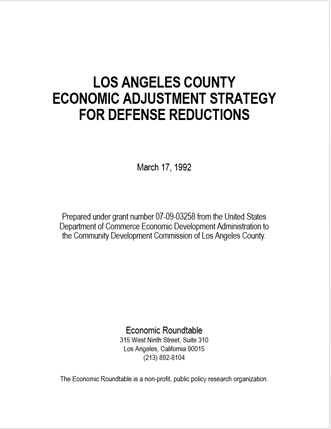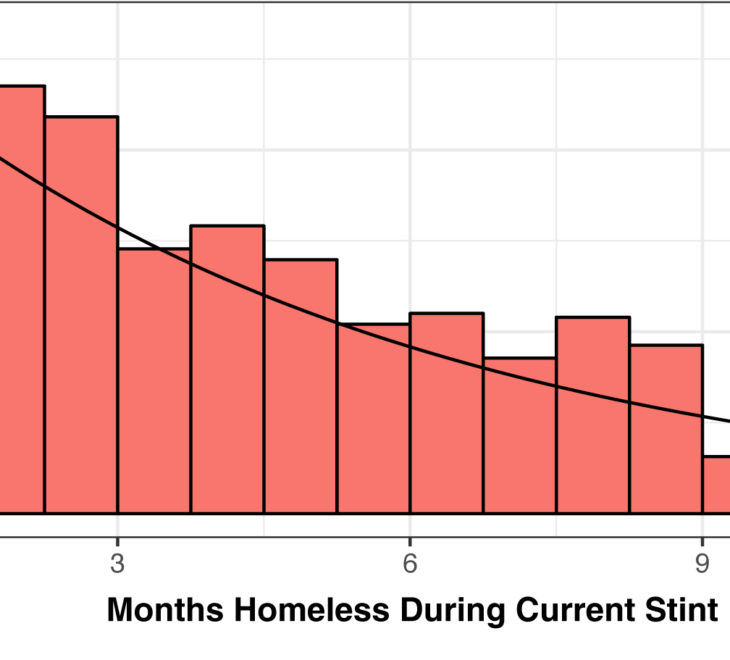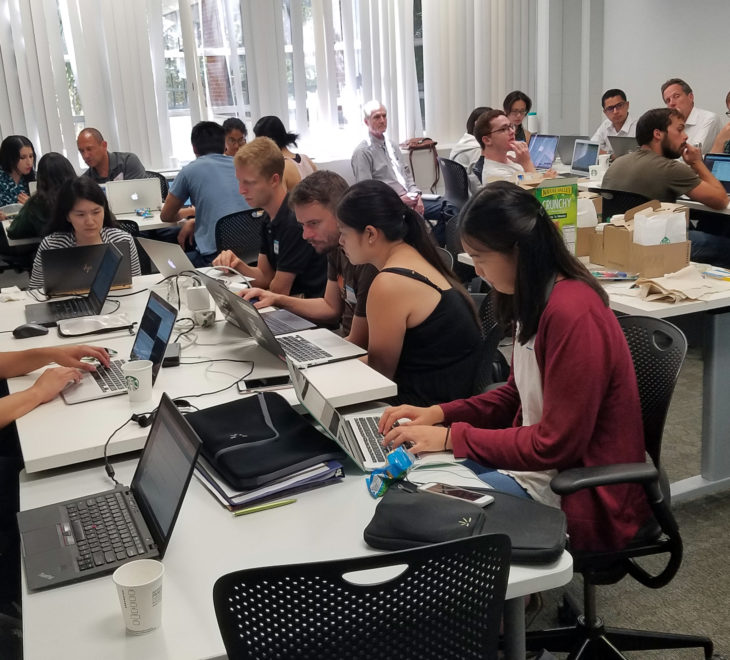 Background
Background
An interdisciplinary research team analyzed information about the labor market, economy, industries, and defense linkages of Los Angeles County. The report recommends an economic adjustment strategy to reduce severe job losses projected as a result of cutbacks in defense funding for Los Angeles County industries. On March 17, 1992, the Los Angeles Times reported these findings under the front-page banner headline, “Aerospace Cuts to Devastate Area, County Study Says.”
Questions investigated in the report include:
- What are the impacts of defense cutbacks on Los Angeles County?
- Who in Los Angeles County needs help?
- Where is help needed?
- What kind of help is needed?
- What kind of help is it possible to provide given the resources and constraints of county, state and federal budgets?
- What kind of help will most effectively meet the immediate and long-term needs of workers and industry in Los Angeles County?
Findings
With total employment of 226,300 workers as of December 1991, the aerospace industry represented 5% of the County’s total employment and 28% of its manufacturing jobs.
In 1991, Los Angeles County high technology firms had annual sales of approximately $30 billion.
Aerospace workers earn from 10% to 20% more than their counterparts in the same occupations in other industries.
Approximately 86% of the County’s aerospace workers live within the County, as compared to 68% for the total County work force.
In Fiscal Year 1990, 1,283 Los Angeles County firms received 4,184 Department of Defense (DoD) contracts worth $8.9 billion.
Los Angeles County’s aerospace industry relies on the DoD for two-thirds of its revenue. The typical aerospace firm in Los Angeles County sells 54% of its products to DoD.
Employment in core defense industries fell by 37,500 jobs from 1988 to 1991, a loss of 17%. From 1987 to 1990 defense funds coming to Los Angeles County declined by about 20%, adjusted for inflation, and the number of contracts declined by 22%.
Three possible ranges of additional aerospace lay-offs from 1992 through 1995 are projected, and a multiplier of two is used to project the total job loss in each range. The low range, reflecting the possibility of lower than expected reductions in defense procurement, is 35,000 aerospace jobs lost, resulting in 105,000 total jobs lost in the economy. The middle range, reflecting current forecasts for the federal budget, is 70,000 aerospace jobs lost, resulting in a total job loss of 210,000. The high range, reflecting accelerated defense cutbacks, is 140,000 aerospace jobs lost, resulting in a total job loss of 420,000.
Every eight dollars in lost defense revenue will cause a twenty-eight dollar loss in the County’s economy as well as a one dollar increase in costs and lost revenue for state and local government.
Large defense firms are not easily able to convert their technology and manufacturing resources to commercial projects. The best growth prospects for the County’s high technology industries are found in smaller firms.
From 1988 to 1991 the proportion of unemployed aerospace workers in the pool of job seekers in Los Angeles County registered with Employment Development Department increased by 360%.
In 1991 nearly 2,000 high tech jobs were lost each month, with an aggregate loss of 54,200 jobs since 1988. Throughout 1990 a weekly average of 6,813 unemployed aerospace and high technology workers in Los Angeles County received Unemployment Insurance.
Many laid-off aerospace workers receive brief exposure to outplacement services, but only one to two percent are being retrained. This means that Los Angeles County is losing the productive capabilities of 5,000 skilled workers a year.
Training should last from 6 to 18 months to enable workers to obtain jobs at skill levels comparable to their old jobs, but virtually no training is being provided that lasts longer than 3 months.
Recommendations
It is recommended that the Board of Supervisors establish a policy objective of implementing an industrial development strategy for Los Angeles County and that it take the following four actions toward achieving this objective:
- Support the policy brokering and research service required to develop and implement the County’s industrial development strategy.
- Request participation of industry, universities and other appropriate government entities in developing an integrated statement of public goals for mass transportation, environmental quality, alternative energy vehicles, and job creation for high technology workers.
- Act on strategic industrial development opportunities identified in this report that require inter-institutional collaboration.
- Develop a unified approach with the County’s Congressional Delegation for obtaining adequate federal resources to respond to economic dislocations caused by defense cutbacks.
A Consortium for Clean Energy and Power Sources should be formed to link the region’s aerospace diversification efforts with what may well become the most advanced and innovative program for energy research and technology commercialization in the world.
Seed funding and technical assistance should be provided for start-up and small high technology businesses that can increase job creation and industrial diversification. Financial and technical assistance should have five objectives:
- Diversify the County’s industrial base by developing new technology-based companies.
- Focus on regional strengths and needs.
- Encourage joint research and development between universities and the private sector.
- Develop entrepreneurial skills and outlook.
- Develop a technologically skilled workforce.
It is recommended that an information clearinghouse be established to collect and disseminate information about:
- Offset transactions which offer potential business opportunities for other firms.
- Foreign trade opportunities.
- Intellectual property which is available for sale or licensing.
- Specifications for technological problems for which firms are seeking a vendor to solve.
Once needed reforms in job training programs have been made, it is recommended that there be a five-fold increase in the level of federal job training funds to make it possible to provide substantive skills training for at least 3,000 laid-off aerospace workers a year.
Local and national need for continuing technological development to solve pressing environmental and transportation problems could provide new market opportunities for Los Angeles County’s high technology industrial complex. With a carefully integrated approach of public policy leadership, effective information systems and brokering of public and private interests the County can retain a leading share of current aerospace markets while at the same time gaining first mover advantage in new markets.
Chapter Headings:
- Defense Dependency & Growth Expectations
- Defense Contracting; Advanced Technology Trends
- Economic Impacts of Cutbacks
- Technology Commercialization
- Community & Workforce Impacts of Unemployment Reemployment Opportunities & Needs
- Job Training
- Economic Adjustment Strategies
- Information Requirements
- Implementation Strategies.












